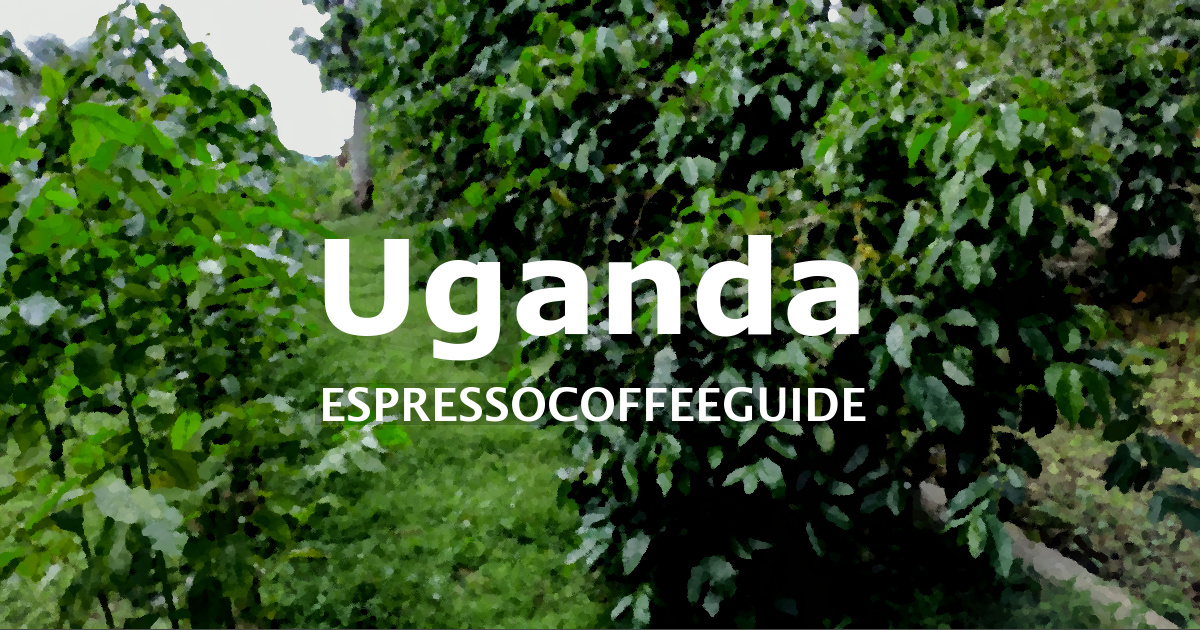Most coffee grown in Uganda (80%) is of the varietal varietal Robusta (Coffea canephora var. robusta), with the other 20% comprising Arabica varietals Typica, SL 14, SL 28 and Kent. Also grown in Uganda is the Arabica cultivar Bugishu / Bugisu (Coffea arabica var. bugishu), which is grown near Sipi Falls on the western slopes of Mt. Elgon, one of Uganda's largest mountains.

- Region: Uganda (Bugisu)
- Growing Altitude: 1,300 - 2,200 meters
- Variety: Arabica (Typica, SL 14, SL 28, Kent)
- Harvest Period: October - February
- Milling Process: Fully Washed
- Aroma: Woodsy, Orange Zest
- Flavour: Orange, Fruity, Pekoe Tea
- Body: Smooth
- Acidity: Winey
Generally, the coffee growing regions are divided into:
- West Nile (Okoro - bordering on Democratic Republic of Congo and Sudan in the North West)
- Northern Region (Lira, Gulu)
- Eastern (Mbale, Bugisu - bordering on Kenya)
- Central & Southwest (Jinja, Mukono, Kampala, Masaka - by Lake Victoria)
- Western Region (Kasese, Mbarara - also bordering Democratic Republic of Congo)
The western regions produce much of the coffees Arabicas, which grow well in the higher elevations including Mount Rwenzori (which actually gets snow at its peaks). These are naturally processed ("drugars").
Jump to:
Tasting notes
A good brewed cup of Bugisu (or "Bugishu") coffee exhibits cupping notes similar to the desirably winey acidity of a fine East African coffee, with sweet chocolate flavor and rich texture. Generally speaking, the lower complexity and lighter lighter body of Ugandan coffees makes them generally less distinguished than the finer coffees of neighboring Zimbabwe, Tanzania, or Kenya.
The Robustas from the Lake Victoria basin are well suited to the clay-rich soils, and benefit from some high elevations in the region. They're able to develop higher acidity than lower-altitude grown Robustas, making them a decent cup.
Uganda Bugishu
This Coffea arabica coffee plant varietal (Coffea arabica var. bugishu) is grown in northeast Uganda near Sipi Falls. Bugishu coffee is distinguished by its clean flavor and distinctive aroma. Some of the best Bugishu (or Bugisu) grows on Uganda's Mt. Elgon.
A good brewed cup of Bugishu coffee exhibits the desirably winey acidity of a fine East African coffee. However, the lower complexity and lighter body of Uganda Coffee makes it generally less distinguished than the finer coffees of Zimbabwe, Tanzania, or Kenya.
Growing
The harvest season for Arabica green coffees is October through February, and all year for the Robusta crop (peaking in November through February). After harvesting, the coffees are either natural washed (known locally as "wugars") or naturally processed (known locally as "drugars").
Interestingly, wild Robusta coffee trees can be found in Uganda due to their suitability to the climate. Theoretically indigenous to Uganda, Robusta is the largest exported coffee varietal in Uganda, which boasts the second largest export volume of the varietal in the world.
Ugandan coffees are graded either "A" (15/16 screen - equal to Colombian "Exelso" size) or "AA" (17/18 screen - equal to Colombian "Supremo" size).
Brewing tips
For tips on brewing the perfect cup of Uganda coffee see the Espresso Coffee Guides section on coffee brewing.
For easy to follow instructions on how to make great Uganda espresso drinks see Espresso Drink Recipes and the How to make a Latte. Also provided are tips on Pulling A Perfect Espresso Shot.
Buy Gourmet Coffee Beans
- ✔️ Fresh roasted to order
- ✔️ 100% high qualtiy Arabica coffee
- ✔️ Custom grind (or whole bean)
- ✔️ 1-way valve, laminate bag (for freshness)
- ✔️ Bulk discounts
Green Coffee Production
| Year | 60kg bags | Coffee grown |
| 2016 | 3,800,000 bags | 501,600,000 pounds |
| 2015 | 3,649,567 bags | 481,742,844 pounds |
| 2014 | 3,744,477 bags | 494,270,964 pounds |
| 2013 | 3,632,867 bags | 479,538,444 pounds |
| 2012 | 3,913,502 bags | 516,582,264 pounds |
Green Coffee Exports
| Year | 60kg bags | Coffee exported |
| 2016 | 0 | 0 pounds |
| 2015 | 3,315,570 | 437,655,240 pounds |
| 2014 | 3,455,250 | 456,093,000 pounds |
| 2013 | 3,499,830 | 461,977,560 pounds |
| 2012 | 3,583,260 | 472,990,320 pounds |
Data may not be available for the most recent year.
Source: ICO
Facts

























produced 481,742,844 lbs
exported 437,655,240 lbs
That's over 91% exported!
Sounds like a lot? It's actually 2.4% of the coffee grown worldwide.

(that's 4,265 to 7,218 ft)
Source: ICO


Gord walker
I’m trying to find bukonzo or similar coffee from East Africa. Can you help me locate it
Musobozi Koroma Eric
Being the biggest foreign exchange earner for our nation, as Ugandans we are in a campaign to hit an export target of 20 millions (60kg) bags by the year 2020 BUT the effects of climate change are a big threat here!
Angila Beitler
I have never heared of Uganda before, thanks for sharing the benefits.
jody clark
Coffee for a Cause. each sip of Ugandan Gold Coffee that we drink provides FRESH DRINKING WATER TO UGANDAN PEOPLE.